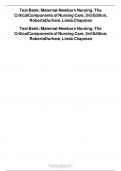Exam (elaborations)
Test Bank: Maternal-Newborn Nursing: The Critical Components of Nursing Care, 3rd Edition, Roberta Durham, Linda Chapman
Test Bank: Maternal-Newborn Nursing: The Critical Components of Nursing Care, 3rd Edition, Roberta Durham, Linda Chapman
[Show more]



